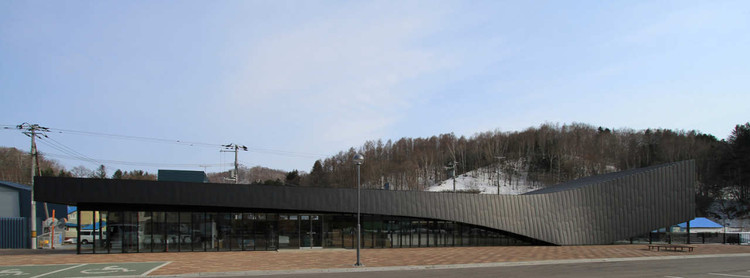
-
Architects: Code Architectural Design
- Area: 371 m²
- Year: 2010
Text description provided by the architects. GR230 is a highway service center located in the town of Kimobetsu, Hokkaido. Situated along Route 230 at the crossroads leading towards Kutchan and Rusutsu, the facility is a vital hub that connects various towns and areas in the Shiribeshi subprefecture, including popular tourist spots, museums, workplaces, homes and a diverse range of other everyday destinations.

GR230’s primary function is to provide services centering on food from the local area. It features a simple, flat layout that consists of shops and kiosks, rest areas, and food and beverage outlets.

This project began in 2005 as part of a plan to widen Route 230, a national highway that runs right through the center of Kimobetsu. The town offered us the use of a site for our proposed building, with the carpark, toilets and tourist office managed by the local municipal government. Construction and business operations were undertaken by private corporations.

A town planning committee was launched in Kimobetsu at the same time that the project was getting started, which we joined from the outset.
One of the issues involved in planning this highway service center was how to project its presence in relation to the passing traffic. We made careful, repeated studies of building forms that would be appropriate to the location as well as how the center would serve as a local landmark, finally deciding that the architecture itself ought to serve as a kind of signboard.

Although the completed form of the building was designed to incorporate multiple meanings within it, the motif on which the shape of the facility was based is in fact concealed within the landscape of ravines and gorges, with Mount Shiribetsu to the south and Mount Yotei to the west.

While the magnificent scenery that surrounds the building may bring to mind a lush, green summer season, this part of Hokkaido actually sees long winters that last for almost half the year. The black band made up of various trees whose leaves have fallen is a bare expression of the vast land that is obscured during the warmer months. Undulations in the structure, combined with color gradations in the black band and the contrast with the white snow-covered fields in the distance, create an abstract visual effect.

When the architectural form of the building first emerged over the course of our studies, we felt as if a vision of the pristine winter landscapes of northern Japan had surfaced from the depths of our memory.
With GR230, we have created a beautiful piece of architecture that commands a dignified presence during the foliage-rich summer months, and a quieter one that seemingly dissolves into the surrounding landscape during the long, reclusive winters.
















